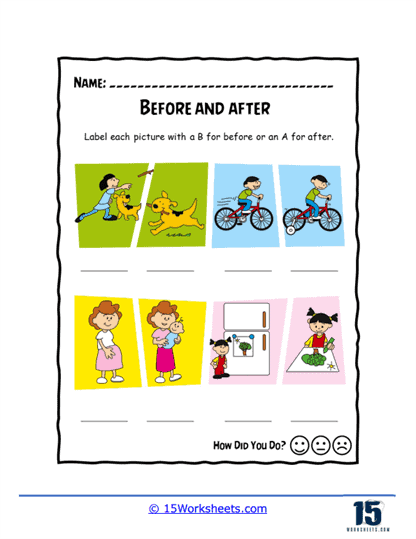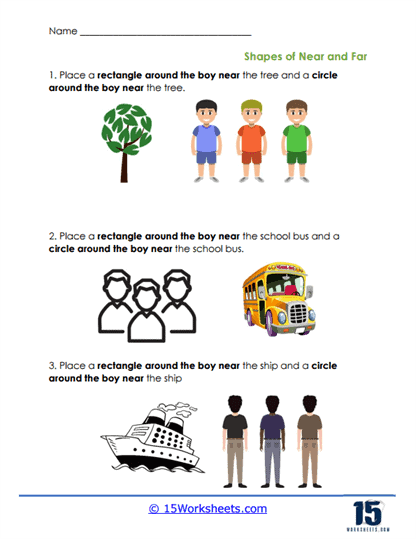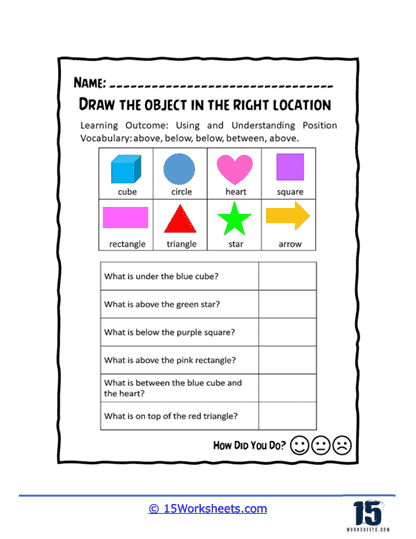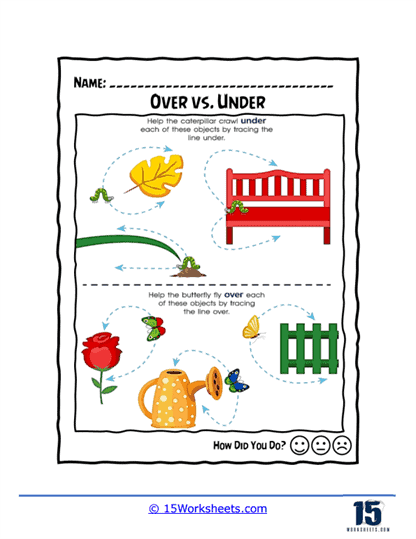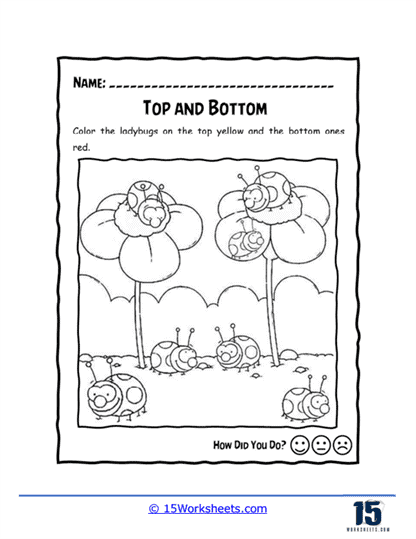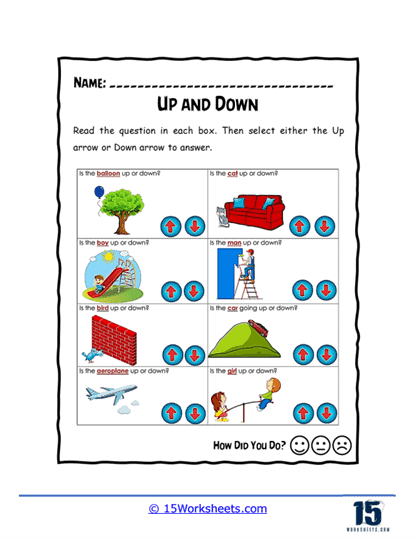Position Words Worksheets
About Our Position Words Worksheets
This collection of worksheets will help young children, especially kindergarten students, understand and practice spatial concepts and vocabulary. These worksheets focus on position words, also known as prepositions, such as “above,” “below,” “next to,” “behind,” “in front of,” and “between.” The goal is to teach children how to describe the location of objects in relation to one another. Typically, these worksheets include visual activities where students are asked to place objects in specific positions or identify where an object is located based on a given preposition.
These worksheets are particularly helpful for kindergarten students because they introduce critical language skills in a fun and engaging way. At this developmental stage, children are learning how to communicate clearly, and understanding spatial relationships is a key part of that process. By using worksheets that incorporate bright, simple images and interactive tasks, children can practice identifying and using position words in context. This not only strengthens their vocabulary but also aids in developing their ability to give and follow directions.
Position words worksheets also support cognitive development by helping children understand how objects relate to each other in space. This spatial awareness is important not just in language development but also in early math skills, such as geometry and measurement, where understanding shapes, patterns, and positions is crucial. By working through these worksheets, students improve their ability to visualize and mentally manipulate objects in space, skills that are foundational for problem-solving and logical reasoning.
These worksheets foster independence and confidence in young learners. As students become more familiar with position words, they gain the ability to communicate their ideas more effectively, whether in conversations with peers or when following instructions from teachers or parents. Through repeated practice, children become more comfortable using prepositions to describe their environment, which is a vital skill for both academic and social interactions.
Position words, also known as prepositions, are words that describe the location, direction, or spatial relationship between objects or elements within a sentence. These words help provide context and clarity in written and spoken language, allowing us to understand where things are in relation to one another.
Common position words that this collection of worksheets tackles include:
- Above: Higher than or over something else.
- After: Denotes something that occurs later or follows another event, action, or position in time or order. It suggests that the referenced event or action takes place subsequent to the point of reference.
- Before: Generally refers to something that occurs earlier or precedes another event, action, or position in time or order. It implies that the referenced event or action happens prior to the point of reference.
- Below: Lower than or under something else.
- Beside: Next to or at the side of something.
- Between: In the middle of two or more things.
- Bottom: The lowest part of an area.
- In front of: Located ahead or before something else.
- Behind: Located at the back or in the rear of something else.
- Near: Close to or a short distance away from something.
- Next To: They are so close that they are almost touching or are touching each other.
- Far: A long distance away from something.
- Inside: Contained within or enclosed by something.
- Outside: Not within or beyond the boundary or limits of something.
- On: Positioned above and in contact with a surface.
- Over: When something is positioned above another object.
- Top: The highest part of an area.
- Under: Positioned below or beneath something else.
Types of Exercises
The types of exercises found on these worksheets can vary widely to cater to different learning styles and to provide a comprehensive approach to the topic. Here are some common types of exercises you might encounter:
Matching Exercises – Students match images or sentences with the appropriate position words. For example, they might draw a line connecting a picture of a cat sitting under a table to the word “under.” These activities require students to complete sentences with the correct position word. For example, a sentence might read, “The ball is _______ the box,” and the student would fill in “inside.”
Picture Labeling and Sorting – A worksheet may have pictures where students need to label parts of the image with position words, such as labeling a star as “above” the mountain. Students sort words or pictures into groups based on their position words, like sorting a group of images into “things above the line” and “things below the line.”
Sentence Writing – Students write their own sentences using a given position word to describe a scenario or an image provided on the worksheet.
Practicing with position words worksheets can significantly enhance a student’s ability to comprehend and describe the spatial relationships between objects. This understanding is fundamental to developing cognitive spatial awareness, which is crucial for navigating and interacting with the world. For example, being able to understand position words can help a student follow directions, participate in physical activities, and describe locations more accurately.
Moreover, these worksheets improve communication skills by expanding a student’s vocabulary and enabling them to give and understand clear instructions. In an increasingly complex world where precise communication is essential, mastery of position words helps students articulate themselves better and understand others more effectively. The ability to use these words can also aid in subjects like math, science, and art, where spatial orientation and the description of positions are often required.
Teaching Position Words
Teaching children position words is a fundamental step in building their spatial awareness, vocabulary, and overall communication abilities. Mastering these concepts allows children to better understand and navigate the world around them, as well as articulate their thoughts more clearly. Introducing position words through engaging activities and practical examples can significantly enhance a child’s comprehension and retention. By using a variety of approaches that integrate play, storytelling, and hands-on experience, educators and parents can create an enriching learning environment where children feel excited and confident about mastering these important terms.
Spatial awareness is a critical cognitive skill that helps children understand where they are in relation to other people and objects in their environment. When children learn position words-such as “above,” “below,” “next to,” “behind,” and “in front of”-they begin to develop the ability to describe and interact with the physical world with greater precision. This awareness is not only useful for everyday interactions but also plays a key role in mathematics, science, and even social skills. For example, understanding “between” can help a child when learning about number lines, while knowing “under” and “over” helps them navigate the playground or classroom safely.
One of the most effective ways to introduce position words is through storytelling. Books that naturally include position words within their narratives are a powerful tool. As you read stories that feature characters interacting with objects in different positions, pause to ask children questions like, “Where is the cat? Is it on top of the bed or under it?” By encouraging children to think about and verbalize the position of objects in a familiar context, you’re helping them internalize these words without making the process feel like a formal lesson.
Incorporating games that involve following directions is another way to reinforce position words in a dynamic and memorable way. A game of “Simon Says,” for instance, can be turned into an opportunity to practice spatial vocabulary. You could give commands like “Put your hand above your head,” or “Stand next to the chair.” Children enjoy the playful nature of these activities, and the repetition helps solidify their understanding of how these words apply to their own movements and actions.
Beyond books and games, hands-on activities can deepen a child’s grasp of position words. By using everyday objects like toys, blocks, or even furniture, children can physically manipulate items as they learn. For instance, you can place a toy car “under” the table and ask the child to retrieve it, or ask them to put a doll “beside” the bed. This type of tactile learning is particularly effective for young children, as they often learn best through physical interaction with their environment.
Incorporating movement into learning can also be incredibly effective. Ask children to physically move themselves in relation to an object-stand “in front of” the door, sit “behind” the desk, or lie “next to” a pillow. These physical experiences not only reinforce vocabulary but also connect the words to real-life situations in a way that is both engaging and memorable. Children are active learners, and allowing them to move while learning reinforces the concepts in a natural and enjoyable way.
Art is another excellent medium for teaching position words. Encourage children to create drawings that involve spatial relationships. Ask them to draw a bird “above” a tree or a boat “in” the water. These exercises not only improve their understanding of position words but also enhance their creativity and fine motor skills. As children describe their artwork, they practice using position words in a meaningful context, which reinforces both their language and artistic skills.
The key to helping children fully grasp position words is to make these concepts a natural part of their daily life. Use position words in regular conversation to create ongoing learning opportunities. Simple phrases like, “Place your shoes next to the door,” or “The book is under the chair,” help children understand the relevance of these words in everyday activities. By consistently using position words in context, children begin to recognize and understand these terms without even realizing they are learning.
Playgrounds are full of opportunities to explore spatial concepts. Whether children are climbing up and down the ladder, swinging back and forth, or crawling through tunnels, they are naturally engaging with position words. Encourage children to describe their actions as they play. “I’m going up the slide,” or “I’m under the bridge” are great ways for them to practice their vocabulary while having fun. Teachers and parents can also guide this process by prompting questions: “Can you slide down the slide?” or “What’s above the swing?” This not only makes learning interactive but also connects words to real-life physical experiences, deepening their understanding of spatial relationships.


